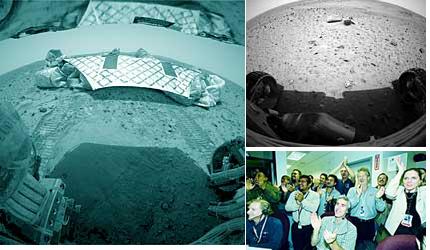Yuval Dror, Haaretz, voila!

In the images on the right: Above: an image sent by Spirit to NASA after leaving the lander. Below: The cheers of the project personnel after receiving the image that confirmed the successful descent of the space vehicle from the lander. In the picture on the left: the lander and the wheel marks, in the picture sent by the space vehicle from Mars. Photo: NASA
Direct link to this page: https://www.hayadan.org.il/spiritupdt160104.html
Yesterday, NASA's space vehicle, Spirit, successfully completed its most important milestone since it landed 13 days ago on Mars: it traveled a distance of three meters, got off the lander it was on and now all six of its wheels are on the ground. Spirit sent a photo showing the lander and the wheel marks he left on the Martian soil. The image was received with thunderous applause by the project team, which is now ready to begin the mission for which Spirit was sent: locating evidence that water once flowed on Mars.
In the last three days, the project managers prepared Spirit for the mission. They lifted it on its wheels and turned it in place at an angle of 115 degrees, so that it would face the rear exit of the landing pad.
This, because the front exit was blocked by airbags.
In addition, Spirit cut all the cables that tied him to the lander. Yesterday at 10:21 am (Israel time) the order was sent from Earth for Spirit to get off the lander.
Photographs: NASA and IP
NASA knew that this was a sensitive mission, partly because Spirit was required to "jump" from the lander to the Martian soil from a height of about 15 cm.
An hour and 40 minutes passed until Spirit sent a message in the form of a "beep", confirming that he had completed the task. NASA reacted with restraint. They waited another 15 minutes until a black-and-white image, captured by Spirit's rear camera, showing the lander and wheel marks of the spacecraft on the Martian soil appeared on the computer screens. The shouts of joy of the project people were reminiscent of the shouts heard at the sight of the first image sent from Mars. "We cut the umbilical cord and our baby is free," said Joel Krajewski, a NASA scientist who takes part in the project.
Since the landing, NASA has adopted a conservative policy, according to which they do a "new thing" only once in Sol ("Sol" is the term for a day on Mars - 24 hours and about 40 minutes). Because of this, after Spirit got off the runway, it was decided not to move it anymore. Instead, the scientists checked the images he sent so they could plan their moves. Spirit's next flyby won't happen for the next three days, as NASA will take advantage of the fact that Spirit is performing well to conduct initial ground checks.
In recent days, dozens of employees have been working at the NASA control center in the US on preparing a special "sandbox" that simulates Spirit's environment. To do this, they analyzed the images sent by the spacecraft and collected rocks and stones that resembled in size and shape the stones and rocks that Spirit photographed. The goal is to accurately plan the most successful route for Spirit.
Indeed, in recent days, NASA has chosen several targets to which they wish to send the space vehicle. Thus, for example, a small crater identified in one of the images sent by the spacecraft was selected. In addition, the scientists want to reach the hills visible in the photos, however the great distance between them and the landing site may prevent this, since according to the plan, Spirit will be able to survive on the surface for no more than 90 days, and is already on the 13th day of the mission.
Spirit, which will travel at a speed of three meters per minute, will use four cameras to detect possible obstacles. The team that built Spirit and its twin "Opportunity", which will land on Mars on January 25, designed it so that it can make decisions on its own if it encounters an obstacle. The reason for this is that due to the distance between the Earth and Mars, the time that elapses from sending an instruction to returning a response from Mars is estimated at about 20 minutes.
Today the scientists will receive a special bonus. The European satellite orbiting Mars, "Mars Express", will fly at an extremely low altitude above Spirit's landing site. The images he will take will allow scientists to see Spirit's surroundings and accurately verify his location.
https://www.hayadan.org.il/BuildaGate4/general2/data_card.php?Cat=~~~742339535~~~16&SiteName=hayadan
